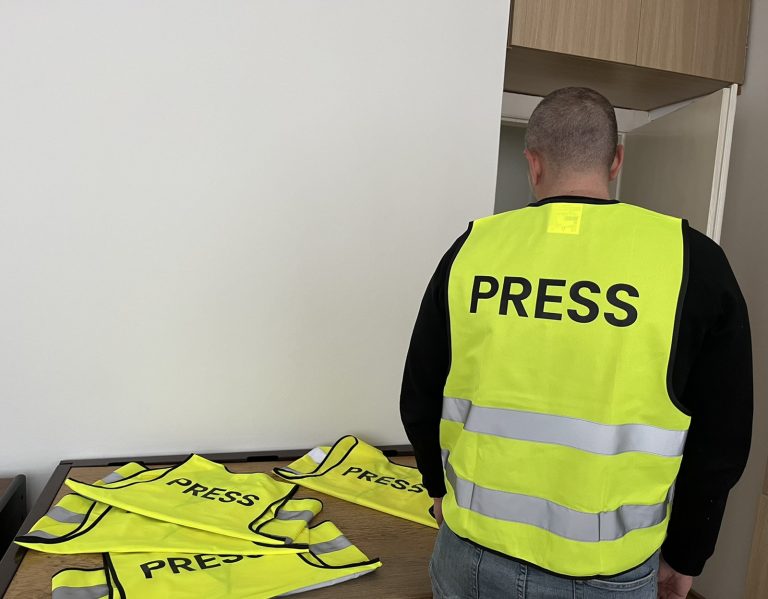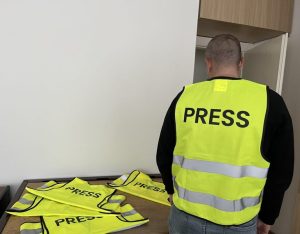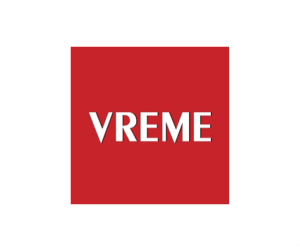What we see in Serbia is the quintessence of state intimidation and coercion, with the aim of media control, holding journalists under duress and self-censorship. It is a war on journalism, free speech, and democracy. As Serbia faces an increasingly violent state response to student-led protest demands for accountability and anti-corruption measures after the tragic death of 16 people as a result of the railway station canopy collapse in Novi Sad, north of the country, on 1 November 2024 almost a year ago, journalists are under assault, including physical attacks, threats and intimidation.
They are being illegally surveilled and attacked by SLAPP lawsuits for asking questions, covering issues, and simply reporting on protests. Journalists are being dangerously branded as “foreign mercenaries”, “terrorists” and “anti-Serbs” by top state officials of Serbia, starting from the president himself.
The verbal assaults by government spokespersons reverberates like an eerie echo on pro-government television, whose national coverage is completely and constantly weaponised against independent media.
The full scale of state attack includes the weaponisation of parallel state structures, including hooligans on the streets and bots in the online space.
Regardless of the reactions of numerous international media and journalists’ organisations, the situation in Serbia continues to deteriorate.
Record number of attacks
The statistics are beyond disheartening.
Since the first day of this year, the Independent Journalists Association of Serbia (NUNS) recorded 289 attacks, threats, and pressures. These include 90 physical attacks, 123 threats to journalists and media, six verbal attacks on media and at least 70 cases of pressure on media workers. The highest number ever, since NUNS began its safety monitoring in 2008.
“There are a large number of cases of pressure yet to be included. There are so many cases every day, that we simply cannot update as fast”, points out Marija Babić, lawyer and researcher of the Independent Journalists Association of Serbia (NUNS), warning:
“The safety of journalists in Serbia is at its lowest level in the past 20 years. The social and political crisis has strongly affected journalists. Frequent protests and police reactions further increase risks that journalists face in the field. While we face a record number of physical attacks on journalists, it is particularly worrying that a significant number of attackers are policemen.”
Instead of protecting journalists, an increasing number report being beaten and assaulted by the police or that the police are unresponsive witnesses to assaults on journalists.
Babić underlines that since March 2025, NUNS has registered 50 cases in which journalists were the target of police violence. In 16 more cases police did not react to attacks on journalists, although the law obliges them to do so.
Veran Matić, president of the Board of the Association of Independent Electronic Media (ANEM) underlines that the most frequent attackers of journalists are “para-police forces” recruited by the ruling party in Serbia, the Serbian Progressive Party, to secure their gatherings.
“Since the beginning of August, members of the intervention units have started physically assaulting journalists. We have recorded more than 22 cases. We also have listed cases of torture and detention. The number of verbal attacks by leading politicians from the executive and legislative branches is increasing”, adds Matić, who claims he has been targeted many times himself.
In September 2025 alone, the Slavko Ćuruvija Foundation registered 141 cases of verbal attacks on journalists and the media by high-ranking state officials and members of the parliamentary majority.
The rule of law stays passive
Most attacks reported target journalists at United Media, the leading media company in Southeast Europe, owner of TV N1, Nova S, daily Danas, and weekly Radar. These media outlets are known for their commitment to independent journalism.
“Our newsroom has recorded at least 40 different attacks (since 1 November), from physical attacks to gruesome death threats. And still, the State does little or almost nothing to protect journalists. It cannot be random ignorance and incompetence. It is their intention to scare journalists and make them leave their job,” says Igor Božić, News Director of TV N1 / CNN exclusive news channel affiliate.
It is certain, Božić points out, that “those threats, targeting in government tabloids, verbal attacks from representatives of the government, throw people out of the focus of their work.”
“These attacks meet the objectives of thugs and political activists. It will remain the case as long as the government, that is, the institutions, do not start doing their job professionally and stop treating “their” and “other” journalists differently, concludes Božić.
Young student and freelance journalists and photojournalists, often lacking newsroom backing, have had an extremely prominent role in reporting on protests.
“They recorded numerous significant moments as they were the target of a large number of attacks. Some of which were extremely brutal,” reminds Marija Babić.
In a rare sharply critical resolution on Serbia, adopted on October 22nd, the European Parliament has condemned “in the strongest terms the wave of state-influenced violence, intimidation and indiscriminate arrests against peaceful protesters, journalists…”,as well as “smear campaigns, [and] intimidation of the media”.
The resolution “urges the Serbian authorities to ensure media freedom” while calling on “senior officials to end inflammatory rhetoric that incites hostility or violence…”
While protests are ongoing, with television N1 being the main source of independent information for many, the Serbian Government “appears to have been negotiating with the owners of the United Media company, to ‘weaken’ independent media outlets operating under it”, namely N1, and warning that “if confirmed, this would represent a serious attack on the already endangered media pluralism in Serbia”.
Impunity is the norm
This is all happening in a country where total impunity exists for the killing of journalists in the 90-s and early 2000s. Impunity continues with the latest wave of violence.
There was only one conviction this year. TheBasic Court in Sremska Mitrovica condemned the attackers of journalist Verica Marinčić, editor of the IN Media web portal and her colleague Miodrag Blečić.
“Impunity is becoming a rule. It directly encourages new attacks and threats. Perpetrators know that they will almost never be sanctioned”, Babić underlines.
“Until last year, we were convincing journalists to wear press vests and other visible identifiers . Now most of them do, but neither the thugs nor the police seem to care… Journalists have become targets,” concluded Matić.
Share Foundation of Serbia has reported more cases of both journalists and activists being targeted by intrusive digital surveillance tools. Some have been forcefully arrested, or summoned, to police stations, and forced to surrender their phones. Without their knowledge, their devices were illegally unlocked and infected with spyware.
As a result of the long-lasting wave of violence and impunity, some Serbian journalists have relocated, while others need protection, and all journalists covering protests need to take special security measures.
There have also been cases of journalists losing their jobs for standing up for ethical reporting. In addition to the stress and pressures of reporting from protests, the majority of journalists and media workers are underpaid, with excessively long working hours, also resulting in stress and burnouts.
Solidarity is essential
Can we really expect the world of high politics, with its diluted and hesitant response to the “journacide” in Gaza, to show genuine concern for the journalists under attack in the southern neighbourhood of the European Union?
Journalists targeted in Serbia have.
In mid-September, the Independent Journalists Association of Serbia (NUNS), the Journalists Association of Serbia (UNS) and the Institute for Media and Diversity – Western Balkans held a rally in front of the Government of Serbia in support of Palestinian journalists reporting from Gaza.
The Association of Independent Electronic Media (ANEM) and the national foundation B92 Fund raised 5,000 euros to assist journalists in Gaza, contributing this week to the Safety Fund established by the International Federation of Journalists.
As the anniversary of the collapse of the canopy approaches on November 1st, with an expected large gathering of citizens in Novi Sad, NUNS and ANEM will be there to help: recommend journalists on how to protect themselves, to record, react and appeal.
But, what will we do to support and protect professional journalists risking their wellbeing to help us see the truth?
This article has been written by investigative journalist Jelena L. Petković. She has been working for many years on combating impunity for crimes against journalists and has over many years conducted research into the killing and disappearance of journalists in Kosovo. She has conducted interviews with more than 200 interlocutors: relatives, colleagues, acquaintances and members of international missions, disclosing new information on the disappearances and killing.
Source: IFJ




